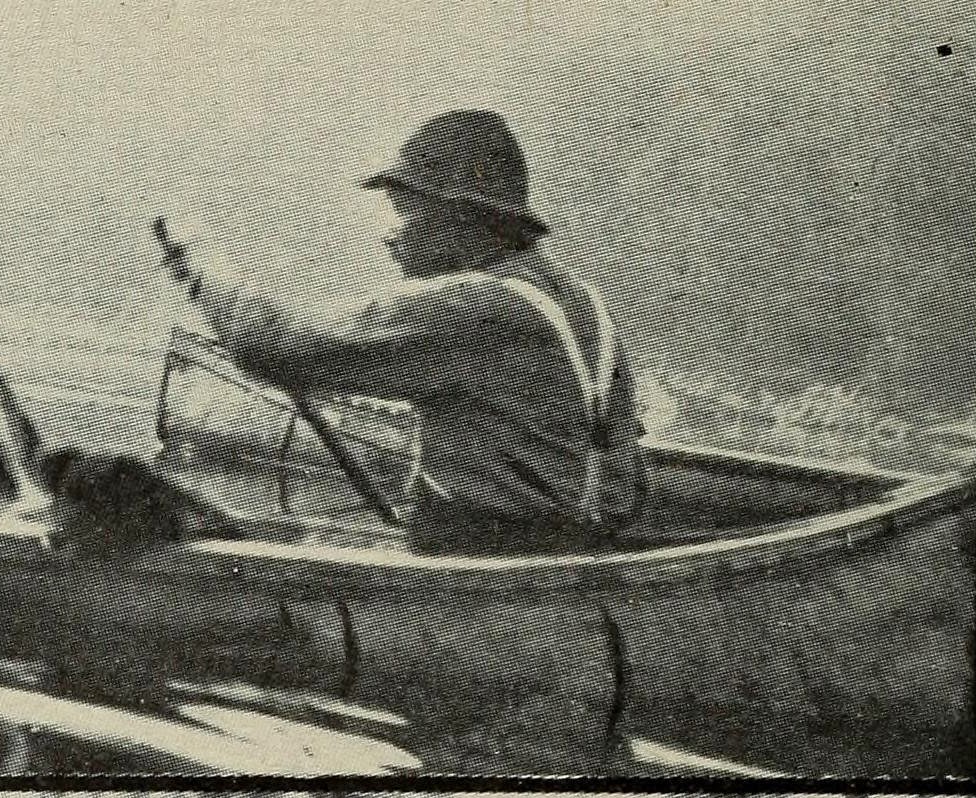Wednesday, November 16, 2016
Indigenous Paddling Technique Part 2
A few of my previous posts have focused on traditional indigenous paddling techniques by First Nation canoeists. While often described as "inefficient" by today's modern paddling gurus, the short, choppy, non vertical stroke is comfortable for me, since nearly all my paddling is done from the kneeling position down low in the canoe.
A few surviving photos also illustrate how the paddle was held with both hands in a more natural, relaxed "push up" position, with the grip hand often grabbing the shaft or loosely draped perpendicular to the grip. Perhaps the best photo of this is described in Robert E. Pinkerton's The Canoe: Its Selection, Care and Use (published 1916).

Pinkerton, RE. The Canoe: Its Selection, Care and Use (1916)
Image Reference Link
Image Reference Link
Here are a few others that have been posted here before...

Ojibwe Chief Busticogan in a bark canoe on the Big Fork River (MN)
Original Post: Historic Photo: Ojibwe Paddling Method
Image Source Link
Original Post: Historic Photo: Ojibwe Paddling Method
Image Source Link

Chippewa Paddlers - Mille Lacs - MN
Original Post here
Recently I found another article describing this method which originally appeared in an article entitled, "Taking the Tip out of a Canoe" by Charles L. Gilman. It originally appeared on page 21 of Field and Stream (April 1927, Vol. 32 No. 12) and expounds on why native paddlers were so stable in their craft. The text portion has been reprinted as a "classic" on Field and Stream's current website (available here). While the language of the article might be distasteful to modern ears, it does provide a clue to the original method of kneeled paddling before seats in canoes became standard. Furthermore, it clearly explains the design need for longer paddles for use with this more lateral canoe stroke.
A few relevant excerpts from the piece:
"The habit of sitting low in the canoe forces upon the Indian a paddle technique which is different from that of the white man and, in general, less efficient. To reach the water he must slant his paddle out, much like an oar. He does not grip with his upper hand across the head of the paddle shaft, but around it, with his thumb toward the blade.
This demands a longer paddle than is required by a white man--one as long as the user is tall, as compared with one standing to the height of the user's mouth if he kneels or to his eyes if he sits to paddle. "
After reading this online, I got interested in searching out the original for photos. Managed to find it in a Library archive and was delighted to see it featured a full frontal shot of a kneeling paddler griping his paddle with this more natural hand positioning.

Field and Stream (April 1927, Vol. 32 No. 12 p21)
The author then goes on to mention a personal observance with a changing technique trend and paddle designs amongst his circle.
"...Within the last fifteen years the paddle with a plain round shaft has been displaced by that widened for a cross grip among the Indians with whom I am familiar. They sit low and grip around the shaft in rough water, and perch very high and use the cross-grip and vertical stroke when things are calm and peaceful and there is no danger."
This observation seemed to clarify why many early surviving paddles simply had a rounded "pole grip" instead of something to comfortably grasp with the hand. After all, with the effort to shape out a blade, carving a rudimentary grip would not take much more effort. However, the the paddler simply gripped the shaft in this more natural position, there would be no need for wasting time and effort on a utilitarian device like a paddle.
As a final aside, another photo of this style of paddle and technique being used. This one dated to the October 1909 of Rod and Gun in Canada...

"Successful Moose Hunts on a Quebec Game Preserve" by F.B. Guild
Rod and Gun in Canada Vol 11. No 5. October 1909
Source Link
The guide in the read is clearly using this method on his pole grip style ...

Image Closeup
Labels:
2,
Indigenous,
Paddling,
Part,
Technique
Subscribe to:
Post Comments (Atom)
No comments:
Post a Comment